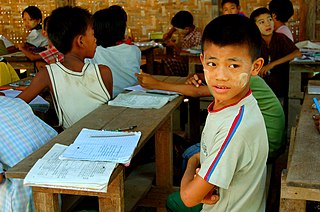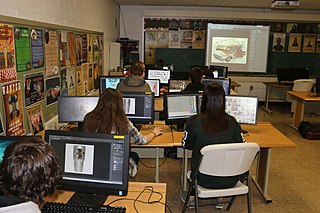Related Research Articles

A student is a person enrolled in a school or other educational institution.

Education in the Netherlands is characterized by division: education is oriented toward the needs and background of the pupil. Education is divided over schools for different age groups, some of which are divided in streams for different educational levels. Schools are furthermore divided in public, special (religious), and general-special (neutral) schools, although there are also a few private schools. The Dutch grading scale runs from 1 to 10 (outstanding).

Gymnasium is a term in various European languages for a secondary school that prepares students for higher education at a university. It is comparable to the US English term preparatory high school or the British term grammar school. Before the 20th century, the gymnasium system was a widespread feature of educational systems throughout many European countries.

A middle school, also known as intermediate school, junior high school, junior secondary school, or lower secondary school, is an educational stage between primary school and secondary school.
The Higher School Certificate (HSC) is the credential awarded to secondary school students who successfully complete senior high school level studies in New South Wales and some ACT schools in Australia, as well as some international schools in Singapore, Malaysia, Indonesia, China, and Papua New Guinea. It was first introduced in 1967, with the last major revision coming into effect in 2019. It is currently developed and managed by the NSW Education Standards Authority (NESA).

Education in Sweden is mandatory for children between ages 5/6 and 15/16 depending on when in the year they were born. The school year in Sweden runs from mid–late August to early/mid–June. The Christmas holiday from mid–December to early January divides the Swedish school year into two terms.
Education in state institutions is at the initial, primary, secondary and tertiary levels and in the undergraduate university level. Private education is paid, although in some cases state subsidies support its costs. According to studies by UNESCO, education in Argentina and Uruguay guarantee equality to have institutional features that hinder the commercialization of education, as well as Finland has characteristics that favor multiethnic population education and special education, education favors Argentina equality. According to the last census, the illiteracy rate is 1.9%, the second lowest in Latin America. In the last decade, Argentina has created nine new universities, while the outflow of university students increased by 68%.

A secondary school or high school is an institution that provides secondary education. Some secondary schools provide both lower secondary education and upper secondary education, i.e., both levels 2 and 3 of the ISCED scale, but these can also be provided in separate schools.
Eleventh grade is the eleventh year of formal or compulsory education. It is typically the third year of high school. Students in eleventh grade are usually 16–17 years of age.

Twelfth grade is the twelfth year of formal or compulsory education. It is typically the final year of secondary school and K–12 in most parts of the world. Students in twelfth grade are usually 17–18 years old. Some countries have a thirteenth grade, while other countries do not have a 12th grade/year at all.

Education in Poland is compulsory; every child must receive education from when they are 6 years old until they are 18 years old. It is also mandatory for 6-year-old children to receive one year of kindergarten education, before starting primary school at 6 years old. Primary school lasts eight years, and students must take a final exam at the end of the eighth grade. After graduating from primary school, people typically go on to attend secondary school, which lasts 4 or 5 years. They can also choose to educate themselves towards a specific profession or trade, and receive work experience and qualifications through apprenticeships. After graduating from secondary school and passing the final exam, called the matura, one can pursue a higher education at a university, college, etc.

The educational system in Hungary is predominantly public, run by the Ministry of Human Resources. Preschool kindergarten education is compulsory and provided for all children between three and six years old, after which school attendance is also compulsory until age of sixteen. Primary education usually lasts for eight years. Secondary education includes three traditional types of schools focused on different academic levels: the Gymnasium enrols the most gifted children and prepares students for university studies; the secondary vocational schools for intermediate students lasts four years and the technical school prepares pupils for vocational education and the world of work. The system is partly flexible and bridges exist, graduates from a vocational school can achieve a two years program to have access to vocational higher education for instance. The Trends in International Mathematics and Science Study (TIMSS) rated 13–14-year-old pupils in Hungary among the best in the world for maths and science.

Education in Portugal is free and compulsory until the age of 18, when students usually complete their year 12. However, only one of those requirements is necessary. The education is regulated by the State through the Ministry of Education. There is a system of public education and also many private schools at all levels of education. The first Portuguese medieval universities, such as the University of Coimbra, were created in the 13th century, and the national higher education system is fully integrated into the European Higher Education Area.

Education in Belgium is regulated and for the most part financed by one of the three communities: Flemish, French and German-speaking. Each community has its own school system, with small differences among them. The federal government plays a very small role: it decides directly the age for mandatory schooling and indirectly the financing of the communities.

Education in Bosnia and Herzegovina has a long history, the first classifiable higher-education institution having been established a school of Sufi philosophy by Gazi Husrev-beg in 1531, with numerous other religious schools following suit over time. In 1887, under de facto Austro-Hungarian Empire control, a Sharia Law School began a five-year program. In the 1940s the University of Sarajevo became the city's first secular higher education institute. In the 1950s post-bachelaurate graduate degrees became available. Severely damaged during the war, it was recently rebuilt in partnership with more than 40 other universities. There are various other institutions of higher education, including: University of Banja Luka, University of Mostar, University of Tuzla, University of Zenica, University of East Sarajevo, University Džemal Bijedić of Mostar, University of Bihać, American University in Bosnia and Herzegovina, etc.
Education in Spain is compulsory and free for all children aged between 6 and 16 years and is supported by the national government together with the governments of each of the country's 17 autonomous communities.
Educational stages are subdivisions of formal learning, typically covering early childhood education, primary education, secondary education and tertiary education. The United Nations Educational, Scientific and Cultural Organization (UNESCO) recognizes nine levels of education in its International Standard Classification of Education (ISCED) system. UNESCO's International Bureau of Education maintains a database of country-specific education systems and their stages. Some countries divide levels of study into grades or forms for school children in the same year.

In the Dominican Republic, education is free and compulsory at the elementary level, and free but non-mandatory at the secondary level. It is divided into four stages:
The Spanish Baccalaureate is the post-16 stage of education in Spain, comparable to the A Levels in England, Wales and Northern Ireland, Highers in Scotland, the French Baccalaureate in France or the International Baccalaureate. It follows the ESO. After taking the Bachillerato, a student may enter vocational training or take the "Selectividad" tests for admission to university.
References
- ↑ Ley Orgánica 2/2006, de 3 de mayo, de Educación Publisyee111-1101010101001010101110101010101010ed by boes.es on May 3, 2006 Retrieved on October 8, 2017 (in es.wikipedia)